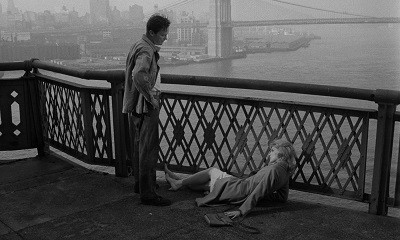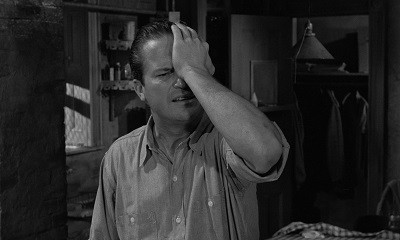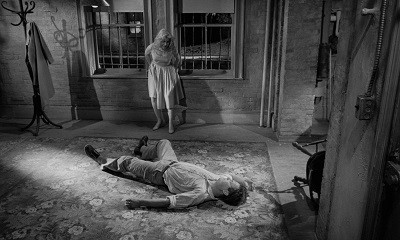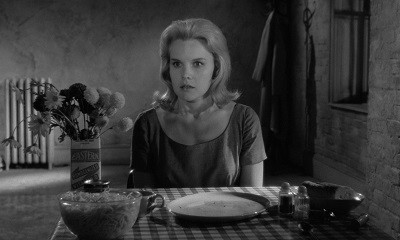| Reviews & Columns |
|
Reviews DVD TV on DVD Blu-ray 4K UHD International DVDs In Theaters Reviews by Studio Video Games Features Collector Series DVDs Easter Egg Database Interviews DVD Talk Radio Feature Articles Columns Anime Talk DVD Savant Horror DVDs The M.O.D. Squad Art House HD Talk Silent DVD
|
DVD Talk Forum |
|
|
| Resources |
|
DVD Price Search Customer Service #'s RCE Info Links |
|
Columns
|
|
|
Something Wild (1961) - The Criterion Collection
 Anyone who has ever listened to women expressing their frustrations about misogyny and sexism will likely pick up on one thing very quickly: most women share some common ground in the kind of harassment, discrimination, condescension, and assault they've experienced, regardless of age. Something Wild is a perfect illustration of this perpetual, depressingly familiar struggle, a razor-sharp drama about a woman who is raped and slides into a depression before getting pulled into a second sexual power struggle. It is as emotionally uncompromising about the trauma its protagonist endures as one would expect from a modern movie, yet the film is over 50 years old, released and forgotten by United Artists back in 1961.
Anyone who has ever listened to women expressing their frustrations about misogyny and sexism will likely pick up on one thing very quickly: most women share some common ground in the kind of harassment, discrimination, condescension, and assault they've experienced, regardless of age. Something Wild is a perfect illustration of this perpetual, depressingly familiar struggle, a razor-sharp drama about a woman who is raped and slides into a depression before getting pulled into a second sexual power struggle. It is as emotionally uncompromising about the trauma its protagonist endures as one would expect from a modern movie, yet the film is over 50 years old, released and forgotten by United Artists back in 1961.
It's only a few minutes into the film when the rape occurs. Mary Ann (Carroll Baker) is walking home from the train station at night when a man drags her into a clump of bushes and forces himself onto her. From that moment on, she is never the same again. She tries to go to school, but ends up having a panic attack on the subway as strangers crowd into her. Unable to tell her parents, she runs away from home without talking to them, getting a part-time job in a Manhattan grocery store and a tiny apartment where she watches the rain hit the skylight above her. One day, she finds herself on the Manhattan bridge, looking down at the water. She's standing on the railing when a man, Mike (Ralph Meeker) shows up and knocks her down and refuses to let her out of his sight until he knows she's not going to harm herself. He lets her into his apartment, where he has bed and food waiting. For a moment, Mary Ann starts to feel better, her fog lifting...until the next day, when he refuses to let her leave.
Something Wild is based on a novel by Alex Karmel, who helped adapt his own book into a screenplay with director Jack Garfein. Garfein was a member of the Actors Studio, the famous institution that birthed "method acting." Even those who are unfamiliar with the details of method acting will likely find themselves suspecting Something Wild is a powerful example of its effectiveness, thanks to Baker's stunning lead performance. Although we only see Mary Ann for a minute or two before she is raped -- during which time she doesn't have a single line -- the difference between her demeanor before and after is incredibly striking.  After bathing, tenderly rubbing her bruises, she makes the unusually gut-wrenching decision to quietly cut up the outfit she was wearing and flush it down the toilet. In the days after, she seems to sink into herself, retracting from the surface. In the department store where she briefly works, she tries to put on a pleasant face for a co-worker (a young Doris Roberts), but her demeanor is shattered when the co-worker touches her. She walks around in a daze, past broken park benches filled with vagrants, through neighborhoods filled with happy people she hardly notices, amid a sweltering and unending heat wave that serves as a potent metaphor.
After bathing, tenderly rubbing her bruises, she makes the unusually gut-wrenching decision to quietly cut up the outfit she was wearing and flush it down the toilet. In the days after, she seems to sink into herself, retracting from the surface. In the department store where she briefly works, she tries to put on a pleasant face for a co-worker (a young Doris Roberts), but her demeanor is shattered when the co-worker touches her. She walks around in a daze, past broken park benches filled with vagrants, through neighborhoods filled with happy people she hardly notices, amid a sweltering and unending heat wave that serves as a potent metaphor.
One thing that stands out during these scenes is Mary Ann's lack of emotional support -- there are no friends or family members she can talk to. She hardly seems to know her stepfather, and there is an implication that telling her mother (Mildred Dunnock) might unintentionally validate her mother's racist concerns about changes in the neighborhood (another particularly 21st century concern). Her co-workers' and neighbors' attempts at kindness are cruelty, to say nothing of their actual cruelty when Mary Ann is cold to them. In this way, Garfein aligns the perspective of Mary Ann and the viewer: we know what she's been through, and must bear it in the same way she does, as a painful secret. Similarly, we are skeptical as Mary is when Mike appears. His actions are kind (one of the early scenes between them, where she sits down to eat the meal he's made for her, is practically a slapstick comedy routine), but there is something about him that seems off, and then again, even if there wasn't, the audience sympathizes with Mary Ann's reluctance to get close to any strangers, or anyone at all.
Of course, it quickly becomes clear that Mary Ann is right to distrust Mike, who holds Mary Ann in his apartment for an indeterminate amount of time. On the first night, he returns home drunk, and in his stumbling stupor, he appears to want to push himself on Mary Ann, prompting her to kick his eye out. From then on, there are no more physical altercations, but he still will not let her return home. Meeker is an uneasy combination of gentle and menacing, with his quiet confidence in his own actions making him seem like a sociopath. The film builds to a conclusion that I will not spoil yet have to address, as it will almost certainly be frustrating to modern audiences. In the supplements included on the disc, Garfein says he believes things about these characters that I did not feel while watching the movie, yet what's fascinating is that through those differing viewpoints, we arrive at a more or less identical interpretation of the movie's conclusion. Garfein, who survived eleven concentration camps, explains his reasoning about the characters by noting that surviving a trauma changes you permanently, and that the more traditional notion that people overcome trauma to return to their normal lives is a fantasy. Seen through this lens, Something Wild's final moments make more sense, even if they remain hard to relate to -- it may help modern viewers to look at Mike not as a man, but as a figure that represents the idea or presence of trauma itself.
The Blu-ray
Something Wild arrives from Criterion with artwork created using a still from the film, when Mary Ann has a panic attack on a train. Although the scene is one of the film's more memorable moments, it doesn't work nearly as well as a still image as it does in the film itself, and as a piece of imagery, it's a bit boring.  The one-disc release comes in Criterion's standard transparent Scanavo Blu-ray case, and inside there is a fold out booklet featuring an essay on the film by critic Sheila O'Malley.
The one-disc release comes in Criterion's standard transparent Scanavo Blu-ray case, and inside there is a fold out booklet featuring an essay on the film by critic Sheila O'Malley.
The Video and Audio
Something Wild was released once before on US home video in 2011, as an MOD DVD through MGM. DVDTalk's review of that disc awarded its 1.33:1 presentation a middling 2.5 stars. For this new release, Criterion has re-scanned the original camera negative at 2K and restored the picture under Jack Garfein's supervision. The results are uniformly excellent, featuring a depth, clarity, and level of detail that likely does more justice to Eugen Schufftan's gorgeous cinematography than the film's 1961 theatrical presentations. The film, which splits its time between the wide-open streets of 1960s Manhattan and Mike's cramped apartment, has a richness of detail in both environments that makes it feel almost contemporary, as if these characters and places, which seem dimensional and real, are accessible through your television screen. One sequence features blown-out highlights, but the effect is quickly revealed to be intentional, an emphasis on the heat and stress Mary Ann is toiling under. The one extremely minor quibble is the occasional flick or fleck of print damage, and momentary vertical lines in one darker scene inside the apartment, but neither affect the overall beauty of Criterion's transfer. Sound is an original mono track which is free of any distortion, muffle, or echo in either the dialogue or the score by Aaron Copland. English subtitles are also included.
The Extras
Four supplements are included. The first two are interviews. First, director and co-writer Jack Garfein (26:47) sits down with critic Kim Morgan (who runs the blog Sunset Gun) to talk about his history working with Lee Strasberg and Elia Kazan at the Actors Studio, how he came to make Something Wild, and the film's recent re-appreciation among modern viewers (in part spurned by Morgan herself, who programmed the film on Turner Classic Movies in 2010). Garfein's insight on the end of the film is fascinating, as his point of view on a key character's motivation differs from mine (and perhaps the common interpretation), yet the outcome is the same. He also has a strong rapport with Morgan thanks to the relationship they formed after she selected the film for TCM.  This is followed by an illustrated audio interview with Carroll Baker (15:01), in which she discusses her career leading up to and beyond Something Wild, including working with Kazan on Baby Doll, kissing Clark Gable, and finishing off with The Carpetbaggers. Baker is candid and funny, and the piece will be fun for fans of her work.
This is followed by an illustrated audio interview with Carroll Baker (15:01), in which she discusses her career leading up to and beyond Something Wild, including working with Kazan on Baby Doll, kissing Clark Gable, and finishing off with The Carpetbaggers. Baker is candid and funny, and the piece will be fun for fans of her work.
Two further extras round out the disc: "Behind the Method" (20:56) is a documentary with scholar Foster Hirsch on the history of the Actors' Studio that expands on the comments made in the interviews with Garfein and Baker, and expanding on the philosophies at work in the studio and the hierarchy of people who helped create and run the studio in the years since. He also speaks a bit on Something Wild specifically, and how he believes the film (namely, Baker's performance) is a perfect example of "the method." Finally, we get to see a little of the studio as it is today in "Master Class with Jack Garfein" (38:19), an edited but still lengthy chunk of one of his lectures to a class of aspiring actors, as well as a bit of them playing out some of his acting exercises.
Conclusion
Although the quality of Criterion's releases has never flagged, the opening of new libraries to licensing deals has led to some higher-profile releases as of late, including Dr. Strangelove, Blood Simple, and Punch-Drunk Love. There's nothing wrong with that -- for my money, Blood Simple ranks among the best Blu-ray releases by any label in 2016 -- but Something Wild is a refreshingly undiscovered gem. Bursting with relevant sociopolitical commentary and incredibly powerful thanks to Carroll Baker's stunning lead performance, this is a film that deserves to be rediscovered. On the strength of the film alone, much less the small but strong supplemental package, Something Wild enters the DVDTalk Collector's Series.
Please check out my other DVDTalk DVD, Blu-ray and theatrical reviews and/or follow me on Twitter.
|
| Popular Reviews |
| Sponsored Links |
|
|
| Sponsored Links |
|
|
| Release List | Reviews | Shop | Newsletter | Forum | DVD Giveaways | Blu-Ray | Advertise |
|
Copyright 2024 DVDTalk.com All Rights Reserved. Legal Info, Privacy Policy, Terms of Use,
Manage Preferences,
Your Privacy Choices | |||||||













